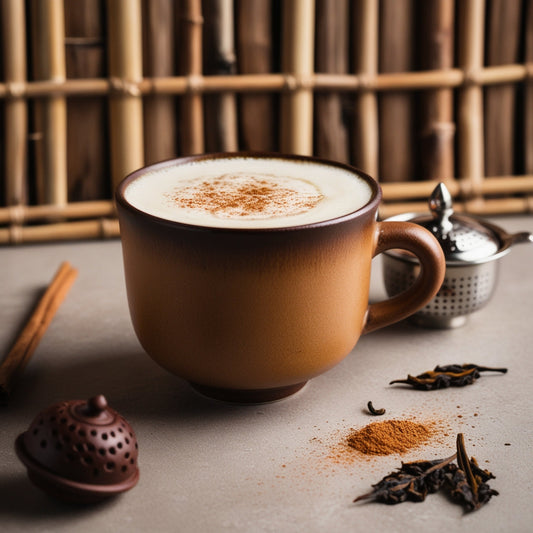Overview
This guide is about Yunnan's tea culture and the unique journey of Yunnan’s Pu-erh tea. It talks about how Pu-erh tea is special and loved by tea lovers everywhere. We will dig further how the tea forests in Yunnan hold the secret to Pu-erh tea's amazing taste and how these tea trees are different from the other part of the tea world.
Table Of Content:
- Introduction
- Diversity Of Yunnan's Tea Culture
- Sustainable Harvesting Practices in Yunnan
- Cultivation of Pu-erh Tea in Yunnan
- Global efforts to Preserve Pu-erh
- Conclusion
Introduction
For a long time, tea trees in Yunnan have been taken care of by the fertile soil. Their roots are deep in the nutrient-rich earth. Also, the perfect combination of soil, weather, and height makes Pu-erh tea grow well here. It is full of flavor and energy. This uniqueness and diversity creates the rich aroma and flavor of Pu-erh tea and makes it one of a kind tea.
Pu-erh is like a small bit of happiness right in the middle of Yunnan. It is truly special and loved by tea lovers everywhere. So why not we take you to this journey along with us and make it unforgettable for you? We are sure you will not regret every single minute spent here.
Diversity Of Yunnan's Tea Culture
To begin with, Yunnan's tea culture has many fertile areas that are perfect for growing Pu-erh tea. First, the land provides the right balance of conditions that give Pu-erh its unique flavor.
Additionally, Yunnan gets plenty of rain and humidity. This creates ideal conditions for tea plants to grow. The humid temperature ensures the plants get enough water to stay healthy as they grow. The mineral-rich soil contributes to the taste and aroma of Pu-erh tea.
Overall, the fertility, rain, sunlight, and humidity contribute to the exceptional growth, flavor, and aroma of this amazing tea.
As a result, these plants grow exceptionally well and produces the best Pu-erh tea in the world.

Yiwu!
Yiwu, one of Yunnan's six ancient tea mountains. It is located south of the Tropic of Cancer, is know as the birthplace of Pu'er tea.
Its lush landscapes, with altitudes ranging from 656 to 2023 meters, have a nurturing environment with an average annual temperature of 17.2°C and ample rainfall.
Furthermore, What’s unique about Yiwu is the nutrient-rich soil, which promotes robust plant growth, making it ideal for cultivating the large-leaf Pu-erh tea variety.
Without a doubt Yiwu’s Pu-erh tea is famous for its unique fragrance and smooth taste., making it a treasure cherished by tea enthusiasts.
With meticulous traditional techniques, Yiwu produces tea cakes of unmatched quality, promising a journey of sensory delight with each sip.
Sustainable Harvesting Culture In Yunnan
Sustainable harvesting practices mean being responsible with how we use resources so that there's enough left for the future. These practices have been developed over many years and focus on keeping ecosystems healthy and resources plentiful. Evolving over centuries, these practices prioritize biodiversity and ecosystem integrity.
While Pu-erh tea cultivation in the Yunnan area it is must to follow the sustainable harvesting practices so that the culture can be kept alive.
So for this people follow these sustainable practices:
Terracing: A foundation of sustainable harvesting, quickly minimizes soil erosion while optimizing land use for increased productivity. Land intensification, with its focus on organic fertilizers and diverse cropping techniques, it nurtures soil health and biodiversity, ensuring sustained yields.
Banning harmful methods: The banning of harmful agricultural methods, such as synthetic pesticides and fertilizers, underscores a commitment to environmental stewardship.
These practices yield ecological benefits by preventing soil erosion, preserving fertility as well as safeguarding precious water resources. By embracing sustainable harvesting, we pave a path towards strong ecosystems and a brighter, healthier future for all.
Cultivation Of Pu-erh Tea In Yunnan
The magical art of cultivating Pu-erh involves carefully maintaining top-notch quality while also protecting the environment through eco-friendly methods:
- Harvesting - The path opens with the plucking one bud and 2-3 leaves in a way that it don’t disrupt the ecosystem of tea trees. Indeed, it is a complete handpicking process.
- Withering - After harvesting the leaves go through fading process. In this the leaves are spread in open for drying so that the moisture gets absorbed and aroma can be empathised.
- Wok-frying - After fading process the leaves are fried by using woods to reduce the carbon emission. Also this process halts oxidation to preserve the natural essence of the tea.
- Rolling and Sun-drying - The processed leaves are further rolled to release essential oil and enhance flavor and this practice also done by the craftsmen prioritising sustainable power resources. Sun-drying process allows the sun to absorb natural sunlight and air. This process reduces the energy consumption compared to artificial drying.
- Fermentation and Ageing - Further the process of fermentation is executed in which the leaves stacked and turmoil in controlled condition. These leaves are kept for 8-10 years to age and transform the aroma.
- Pressing, Shaping and Storage - Once the leaves are fermented, the Pu-erh tea leaves are kept and compressed into various shapes like- cakes, bricks and tuo cha(bird’s nest). This eco-friendly process ensures use of sustainable materials. As the final step, Pu-erh tea is lovingly stored to mature, developing beautiful flavors over time in perfect harmony with nature's own climate control.
Global Efforts To Preserve Pu-erh
Due to deforestation, increase of pesticides, unethical farming practices efforts are now being made to preserve the centuries-old culture of Yunnan because Pu-erh tea stands as a symbol of natural harmony, preserving centuries-old traditions with minimal impact on the ecosystem. Craftsmanship from local communities plays a crucial role in this effort.
Additionally, efforts are also being made to preserve these ancient trees, which have been around for more than a hundred years, they are keeping the nature alive. These trees hold important genetic differences that we need to keep safe.
When people make Pu-erh tea, they make sure to collect the leaves in a way that doesn't hurt these special trees. It's all about being careful and respectful towards nature's treasures.
Furthermore, Initiatives such as Organic Certification ensure transparency and fairness in tea production. By prohibiting harmful agricultural practices and promoting community development, these initiatives uphold sustainability, biodiversity, and cultural heritage.
In addition, their commitment to preserving this adored legacy, Pu-erh tea producers pave the way for a sustainable future, where the beauty of nature and tradition grows for generations to come.

Conclusion
In conclusion, it is must to headline the Yunnan culture, how this culture is unique in it’s own ways. It is only because of the people who still cares about the environment and the legacy of Yunnan. Let’s take a moment to appreciate the efforts and amazing craftsmanship behind Pu-erh tea.
Every leaf has a story of the rich environment and cultural heritage of Yunnan's tea culture. So let’s choose Pu-erh tea not only for our benefits but also to inspire generations to come. People should know the sustainable practices which are followed for this amazing tea.
Finally, with Pu-erh Craft join us in raising a pledge to the guardians of Pu-erh.
Together let’s taste Pu-erh and make a difference. Don't miss the chance to explore the exclusive range of Pu-erh, guaranteed to treat your taste buds and offer a journey through the essence of this remarkable tea.
Q&A Section
1. What makes Yunnan the perfect environment for the flavor and aroma of Pu-erh ?
A1. Yunnan’s fertile soil, ample rainfall as well as sustainable farming practices creates optimal conditions for Pu-erh cultivation.
2. What is the difference between raw and ripe Pu-erh tea ?
A2. Raw Pu-erh tea undergoes natural fermentation over time, while ripe Pu-erh tea undergoes a controlled fading process, resulting in differences in flavor, aroma, and appearance.
3. How does Pu-erh tea contribute to sustainable agriculture and environmental conservation ?
A3. Pu-erh tea production often involves sustainable harvesting practices, such as organic cultivation, which prioritize biodiversity, soil health, and environmental stewardship. Thus, contributing to a more sustainable agricultural system.
4. Why should you choose Pu-erh tea ?
A4. Choosing Pu-erh supports in protecting traditional practices and helps in making a positive impact on both he environment and future generations.






